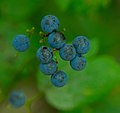Caulophyllum thalictroides
| Caulophyllum thalictroides | |
|---|---|

| |
| Scientific classification | |
| Kingdom: | Plantae |
| Clade: | Tracheophytes |
| Clade: | Angiosperms |
| Clade: | Eudicots |
| Order: | Ranunculales |
| Family: | Berberidaceae |
| Genus: | Caulophyllum |
| Species: | C. thalictroides
|
| Binomial name | |
| Caulophyllum thalictroides | |
Caulophyllum thalictroides, the blue cohosh, is a species of flowering plant in the Berberidaceae (barberry) family. It is a medium-tall perennial with blue berry-like fruits and bluish-green foliage. The common name cohosh is probably from an Algonquian word meaning "rough".[citation needed] The Greek-derived genus name Caulophyllum signifies "stem-leaf", while the specific name thalictroides references the similarity between the large highly divided, multiple-compound leaves of meadow-rues (Thalictrum spp.) and those of blue cohosh.
Description
[edit]From the single stalk rising from the ground, there springs a single, large, three-branched leaf, giving rise to a yellow-flowered inflorescence, followed by bluish berries, coated with a glaucous, waxy bloom, somewhat similar in appearance to sloes. The bluish-green leaflets are three-lobed and entire at the base, but serrate at the tip.
Habitat and Distribution
[edit]The plant is found in hardwood forests and favors moist coves and hillsides, generally in shady locations, in rich soil. It grows in eastern North America, from Manitoba and Oklahoma east to the Atlantic Ocean.
Pollination
[edit]The plant is pollinated early in the season by certain bee species, which are attracted by the nectar glands present on the petals.[1]
Uses
[edit]The plant has been used as a medicinal herb by American Indians.[2] Many Native American tribes, and later European herbologists and mid-wives,[3] would use this herb in conjunction with other herbs and fluids for abortive and contraceptive purposes.[4]
The seeds have also reportedly been used a coffee substitute.[1]
Gallery
[edit]-
Colored plate from Millspaugh’s American Medical Plants showing anatomical detail of flower and creeping rhizome
-
Mature clump of plant
-
Inflorescence of green-flowered form
-
Close-up of single flower and flower bud (green-flowered form)
-
Inflorescence of purplish-green-flowered form
-
Detail of inflorescence of purplish-green-flowered form, showing single flower full-face
-
Young, flowering shoot of deep-purple-flowered form (leaves still tightly furled)
-
Lateral view of young inflorescence of purple-flowered form (flowers three-quarter-face)
-
Single flower (full-face), flower buds and still furled young foliage of purple-flowered form
-
Unripe berries and mature foliage
-
Infructescence, bearing three ripe berries and many tiny, green, undeveloped fruit (lateral view)
-
Ripe berries of infructescence, viewed from above
-
Two Thalictrum species, showing the foliage referenced in the specific name of
C. thalictroides
Chemical Composition
[edit]The root contains essential fatty acids, glucosides, phytosterols, saponins, and resinous essential oil.[5]
See also
[edit]- Black cohosh (Actaea racemosa), although similarly named, is actually a plant in a separate genus.
References
[edit]- ^ a b Niering, William A.; Olmstead, Nancy C. (1985) [1979]. The Audubon Society Field Guide to North American Wildflowers, Eastern Region. Knopf. p. 416. ISBN 0-394-50432-1.
- ^ Cichoke, Anthony J. (2001). Secrets of Native American herbal remedies: a comprehensive guide to the Native American tradition of using herbs and the mind/body/spirit connection for improving health and well-being. Penguin. pp. Blue Cohosh. ISBN 1-58333-100-X.
- ^ Henriettesherbal. "Herbal Abortives and Birth Control". Henriettes-herb.com. Retrieved 24 February 2012.
- ^ Sisterzeus. "Blue Cohosh". Sisterzeus.com. Retrieved 24 February 2012.
- ^ Schneider, Anny (2020). Plantes médicinales indigènes du Québec et du sud-est du Canada [Native Medicinal Plants of Québec and South-East Canada] (in French). Canada: Les éditions de l'homme. p. 65. ISBN 978-2-7619-5256-9.
External links
[edit] Data related to Caulophyllum thalictroides at Wikispecies
Data related to Caulophyllum thalictroides at Wikispecies













